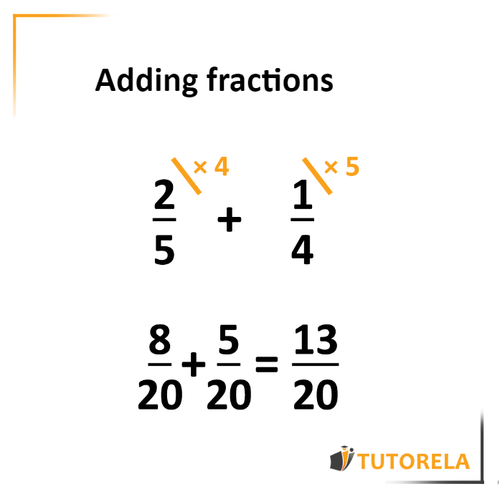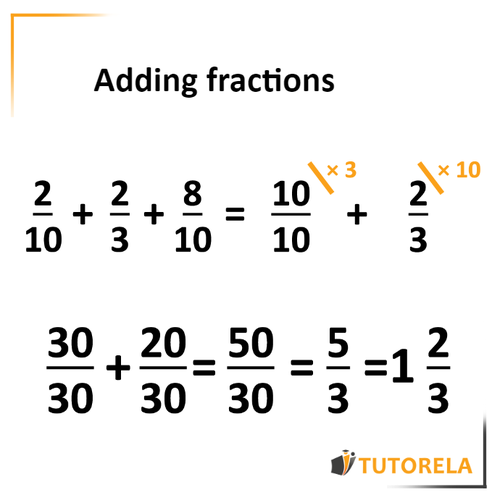To add fractions, we must find the common denominator simplifying, expanding, or multiplying the denominators.
Then, you only need to add the numerators to get the result.
Sum of Fractions
Test yourself on addition of fractions!

\( \frac{2}{4}+\frac{1}{4}= \)\( \)
Sum of Fractions
In this article, you will learn the easiest ways to add fractions, this will allow you to add all kinds of fractions without any inconvenience.
Shall we start?
The first step to solving a fraction addition is to find the common denominator.
Getting a common denominator means that we end up with two fractions with the same denominator. We will do this by simplifying, expanding, or multiplying the denominators.
After finding the common denominator, we will continue with the second step.
The second step to solving a fraction addition is to add the numerators.
We may encounter different cases of additions that we will study next:
First case:
One of the denominators that appear in the initial exercise will be the common denominator.
Sometimes we will encounter quite simple fractions where we won't need to expand or simplify both, but only one of the fractions.
Let's see an example:
Upon observing these denominators, we will immediately realize that, if we multiply the denominator by , we will reach the denominator .
This way, we will reach the common denominator and will be able to solve the exercise easily.
Observe -> When multiplying the denominator to transform it into the common denominator, we must also multiply the numerator by the same number so that the value of the fraction does not change.
We will do this by expanding by and we will obtain:
Now let's move to the second step and add the numerators.
Attention –> We do not add the denominators. Once we reach the common denominator, only the numerators are added, which, in fact, have the same denominator.
Let's see it in an exercise:
We add and leave the denominator only once.
If we wish, we can simplify the fraction and write it as follows:
Another exercise:
Solution:
We will realize that, if we multiply by we will reach and, this will be the common denominator.
We will obtain:
Let's add the numerators and we will obtain:
We can simplify and arrive at:
\( \frac{1}{4}+\frac{3}{4}= \)
\( \frac{1}{2}+\frac{1}{2}= \)
\( \)\( \frac{4}{5}+\frac{1}{5}= \)
Second case:
The common denominator will be the product of the given denominators.
Sometimes we will encounter slightly more complicated exercises in which it will not be enough to expand a single fraction to obtain the common denominator, but rather, we must intervene in both fractions.
Do not worry, the way to act in such a case is simply to multiply the first fraction by the denominator of the second and multiply the second fraction by the denominator of the first.
See how simple this is:

Let's multiply the denominators:
We will multiply the by (the denominator of the second fraction) and the by (the denominator of the first fraction).
We will obtain:
Let's add the numerators and we will arrive at the solution:
Did you see how simple it was? This is a technical method that does not require us to think about how to reach the common denominator.
Therefore, we recommend using it in all fraction addition exercises.
Third case:
Sum of fractions
In case there are fractions with different denominators in the exercise, we will first find a common denominator for of them (the simplest ones), then we will find the common denominator between the one we obtained and the third given fraction.
Let's see an example and you'll see it's very simple:
Let's look at the denominators and ask ourselves - Among the three denominators, which pair of them is easier to find a common denominator for?
The answer is and , since is the common denominator for both.
Therefore, we will multiply by and we will get:
Now we can add the numerators that already have a common denominator to arrive at a clearer and more orderly exercise (this step is not mandatory, but it will help us later.

Now we just have to find the common denominator between -> the new denominator we found, and the third denominator of the exercise.
We will do this with the method of multiplying denominators and we will get:
Let's add the numerators and we will get:
We can simplify and arrive at:
Examples and exercises with solutions for adding fractions
Exercise #1
Video Solution
Step-by-Step Solution
To solve this problem, let's follow these steps:
- Step 1: Identify that both fractions and have the same denominator.
- Step 2: Add the numerators together while keeping the denominator the same.
- Step 3: Simplify the resulting fraction if possible.
Now, let's perform these steps:
Step 1: The denominator for both fractions is 4, so we can proceed with addition.
Step 2: Add the numerators: .
Step 3: Place the result over the common denominator: .
Therefore, the result of adding is .
This matches the correct choice, which is .
Answer
Exercise #2
Video Solution
Step-by-Step Solution
To solve the problem of adding the fractions and , we can follow these steps:
- Step 1: Identify that both fractions share the same denominator of 4.
- Step 2: Add the numerators directly: .
- Step 3: Retain the common denominator, giving us .
- Step 4: Simplify the result, .
Therefore, the sum of and is .
Answer
Exercise #3
Video Solution
Step-by-Step Solution
To solve this problem, we'll follow these steps:
- Step 1: Verify that both fractions have the same denominator.
- Step 2: Add the numerators of the two fractions.
- Step 3: Retain the common denominator.
- Step 4: Simplify the resulting fraction if needed.
Let's work through each step to add :
Step 1: Both fractions have the same denominator: 2.
Step 2: Add the numerators: .
Step 3: The denominator remains the same: 2.
Now the sum is: .
Step 4: Simplify if needed: .
Therefore, the solution to the problem is , which corresponds to answer choice 2.
Answer
Exercise #4
Video Solution
Step-by-Step Solution
To solve the problem, we'll proceed with the following steps:
- Step 1: Ensure the fractions have the same denominator.
- Step 2: Add the numerators while keeping the common denominator.
- Step 3: Simplify the resulting fraction if needed.
Now, let's execute these steps:
Step 1: Both fractions, and , have the denominator 5.
Step 2: Add the numerators: . Keep the common denominator: .
Step 3: Simplify the fraction . Since the numerator and denominator are the same, this simplifies to 1.
Therefore, the answer is .
Answer
Exercise #5
Video Solution
Step-by-Step Solution
To solve the problem of adding the fractions and , we will utilize the fact that these fractions have the same denominator.
Here are the steps we will follow:
- Step 1: Identify the fractions to be added. We have and .
- Step 2: Notice that both fractions have the same denominator, which is 5.
- Step 3: Add the numerators of the fractions while keeping the denominator unchanged.
- Step 4: The sum of the numerators is .
- Step 5: Therefore, place the sum of the numerators over the common denominator 5, giving us .
Thus, the sum of and is .
Answer
\( \frac{2}{5}+\frac{1}{5}= \)
\( \frac{2}{6}+\frac{3}{6}= \)
\( \frac{2}{6}+\frac{1}{6}= \)
More Questions
Addition of Fractions
- Solve (1/4 + 7/4 - 5/4 - 1/4) × 10 ÷ 7 ÷ 5: Complete Solution
- Solve: -3/8 - (-5/8) - (-1/2) | Multiple Negative Fractions
- Solve -14/7 + (-3) - 1/2 - (-1/4): Combined Operations with Fractions
- Solve: -4/16 - (-3/8) + 2/8 + (-1/4) | Mixed Fraction Operations
- Mathematical Expression Comparison: Identifying the Maximum Value Exercise
- The Order of Basic Operations: Addition, Subtraction, and Multiplication
- Order of Operations: Exponents
- Order of Operations: Roots
- Division and Fraction Bars (Vinculum)
- The Numbers 0 and 1 in Operations
- Neutral Element (Identiy Element)
- Order of Operations with Parentheses
- Order or Hierarchy of Operations with Fractions
- Opposite numbers
- Elimination of Parentheses in Real Numbers
- Addition and Subtraction of Real Numbers
- Multiplication and Division of Real Numbers
- Multiplicative Inverse
- Integer powering
- Positive and negative numbers and zero
- Real line or Numerical line
- Subtraction of Fractions
- Multiplication of Fractions
- Division of Fractions
- Comparing Fractions
- Mixed Numbers and Fractions Greater Than 1
- Addition and Subtraction of Mixed Numbers
- Multiplication of Integers by a Fraction and a Mixed Number
- Remainder of a fraction
- Remainder and Mixed Number
- Remainders
- Order of Operations - Exponents and Roots
- Special cases (0 and 1, reciprocals, fraction line)









